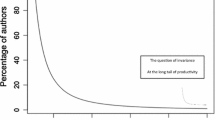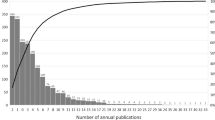Abstract
There has been considerable interest in studying how the research output of a group of N researchers depends on the group-size, N. Several workers have studied this, but with conflicting conclusions, ranging from finding constant per-capita output to per-capita output varying linearly as N, and even exponentially with N. The present communication states afresh the author's earlier theory of productive interactions and gives analyses of the outputs of two prolific research groups: one from Dhaka University, Bangladesh, and one from Karachi University, Pakistan, each over nearly two decades. The data, obtained from published bibliographies, are sub-divided into small successive ranges of lab. group size, 1–2, 3–4, 5–6, etc., and analyzed by calculating the relevant publication-rate per person (R) for each range. Plots of the data from each group show evidence of an initial approx, linear rise of per-capita publication rate, R, up to about N=5, followed by a maximum at group-size of 6 to 8 persons. This group size would correspond to the optimum efficiency, as a balance between the benefits of increasing interaction (α N2) and Parkinsonian loss of efficiency. This is in agreement with the first peak in the author's earlier analysis (of recent U.K. and U.S.A. data) published five years ago inScientometrics, as well as his previous work published elsewhere. Possible reasons for the failure of statistical criteria to show up this phenomenon of increasing per-capita output are indicated and further indepth studies on two University research groups are planned.
Similar content being viewed by others
Notes and references
M.M. Qurashi, The optimum size of research groups for maximum effectiveness. Part I- Statistical formulation and analysis of the data for U.K., Canada and Pakistan,Pakistan J. Sci. Ind. Res., 12 (1969) 1–7. This shows the presence of two maxima, one at N=28 and the other at N=70 in the size distributions, of applied research groups.
Ibid.,Pakistan J. Sci. Ind. Res., 12 (1969–70) 315–323. This provides a theoretical explanation for the empirical size distributions, using three assumptions viz. (i) the maxima correspond to max. percapita output, i.e. efficiency, (ii) per-capita output of a group of N researchers is proportional to (N)1+m, where 0<m<1 and (iii) the Parkinsonian fall in efficiency in given approximately by 1/{1+(N/N0)α+m}, where was α 1.8−m/2 and N0 was estimated from the data.
Ibid.,Proc. Pakistan Acad. Sci., 9 (1972) 109–117. This provides direct evidence for the variation of per-capita output of groups from zero to maxima at N ∼20 and N∼80, followed by a slow fall towards zero with increasing N.
Ibid.,Proc. Pakistan Acad. Sci., 12 (1975) 1–13. This provides data to show that research groups in university department (and similar units) also show two maxima in the size distributions, but at N=5±1 and N=15±5.
M.M. Qurashi, A study of procedures of selecting and channelizing scientists for research and development. Part III-Cyclic variations in output,Pakistan J. Sci. Ind. Res., 12 (1969) 499–504. In the course of a study of the annual per-capita output of several established Pakistan Scientists, a cyclic variation is found: two prolific scientists' groups are also studied, data on one of which (M.H.K.'s group) are now utilized in the present paper.
C.N. Parkinson,Parkinson's Law and Other Studies in Administration, The Riverside Press, Cambridge, Mass, U.S.A. 1957, pp. 4–6 and 7–10. A first approximate mathematical formulation of Parkinson's law has been presented in Ref 2 above.
J.E. Cohen, Publication rate as a function of laboratory size in three biomedical research institutions,Scientometrics, 3 (1981) 467–487. He concludes that one additional scientist increases the no. of publications of a laboratory by 1.1, regardless of size of laboratory.
M.M. Qurashi, Publication rate as a function of the laboratory/group size,Scientometrics, 6 (1984) 19–26. Using a finer analysis of the data from Ref. 7J.E. Cohen, Publication rate as a function of laboratory size in three biomedical research institutions,Scientometrics, 3 (1981) 467–487, this paper shows that the per-capita output is, in fact, nearly proportional to N2 for N<5.
J.E. Cohen, Statistical theory aids inference in scientometrics, etc.Scientometrics, 6 (1984) 27–32. This is essentially a rejoinder to Ref.8, criticizing the method of analysis, and defending the conclusions in his earlier paper at Ref. 7J.E. Cohen, Publication rate as a function of laboratory size in three biomedical research institutions,Scientometrics, 3 (1981) 467–487.
J.J. Wallmark, S. Eckerstein, B. Langered, H.E.S. Holmqvist, The increase in efficiency with size of research teams,IEEE Transactions on Engineering Management, EM-20 (3) (1973) 80–86. These authors' define “research efficiency” as the ratio of [no. of references] to [team size]. On this basis, they find that the group's “research efficiency” varies exponentially with the no., N, of scientists in the group.
Pansdoc (Dacca) Bibliography No. 10 (1965); Research Publications of Prof. M.H. Khundkar, Head of Department of Chemistry (and his group). These have been broken down topic-wise into 6 sections, each containing 10 to 20 papers.
Achievements of Department of Zoology- 1952–54; Karachi University, published for the 5th Pakistan Zoological Congress, 1985. Also gives lists of teaching staff, projects and degrees awarded.
M.M. Qurashi, Per-capita publication rate in relation to optimum size of research groups,Proc. Pak. Acad. Sci., 26 (1989) 273–276. This brings out the factual correspondence between peaks in publication-rate and maxima in frequency-distribution of group sizes.
Author information
Authors and Affiliations
Additional information
Dedicated to the memory of Michael J. Moravcsik
Rights and permissions
About this article
Cite this article
Qurashi, M.M. Publication-rate and size of two prolific research groups in departments of inorganic chemistry at Dacca University (1944–1965) and Zoology at Karachi University (1966–84). Scientometrics 20, 79–92 (1991). https://doi.org/10.1007/BF02018146
Received:
Issue Date:
DOI: https://doi.org/10.1007/BF02018146




